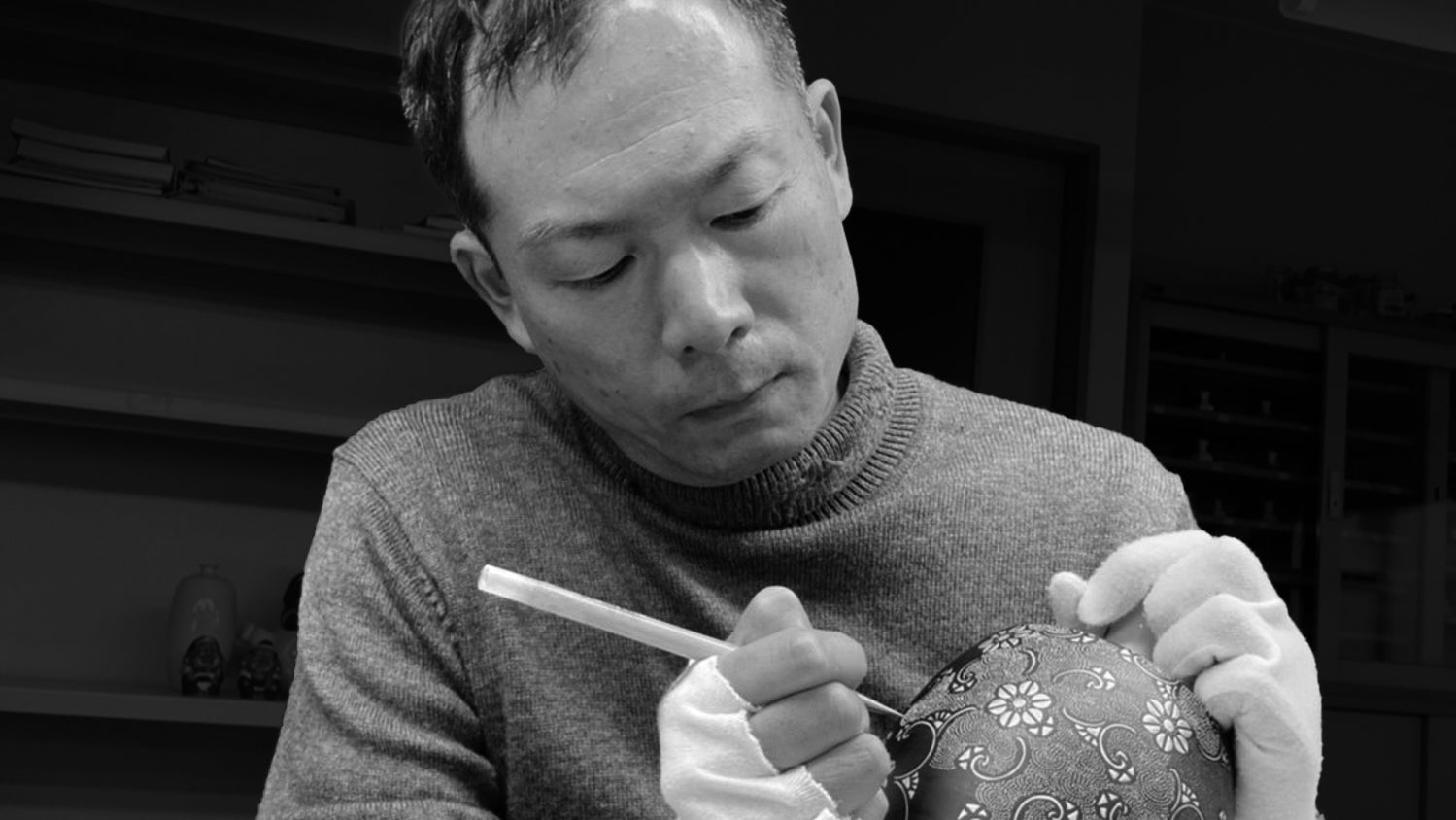
Nakada Kingyoku: The Evolving Legacy of Kutani Ware's Decorative Paintings
Nakada Kingyoku is a master of the morikin and aochibu painting style. The morikin "raised gold" technique breathes life into patterns with special paints, raised like tiny islands in a sea of porcelain, only to be crowned with gold. The aochibu "blue dots", are delicately dotted on the canvas using the icchin tool, each dot a showcase of precision and elegance.
We visit his workshop in Ishikawa Prefecture to explore his journey to becoming an artisan and the challenges that have shaped his career. Additionally, we delve deeply into the visionary approaches he employs to advance the style into new realms of creativity and wonder.
tables of contents
Journey in Mastering the Aochibu Technique
"Until then, I worked in a regular company. As a child, the profession itself was well known and in demand, so I didn't think much about taking over. But as fewer and fewer people worked in this industry over the years, around the age of thirty, my father said, 'If you're going to take over, you need to start training soon because it takes time to learn.' At that time, I didn't think too deeply about it."

"At first, sitting down for a long amount of time was really tiring, but after a few months, I got used to it. Now, I can sit all day without getting tired. In fact, I think sales work was more tiring."
Over time, he became comfortable with the lifestyle of a craftsperson. People generally think that becoming a Kutani ware artisan requires decades of training and years of practice. Nakada's formal training lasted about ten years in total, under the tutelage of the second generation. He took the title of third generation after seven years of apprenticeship under him. Now, after ten years, having honed the skills he inherited, he is able to create original works.

"At first, I didn't particularly want to create original works, but gradually, my works began to reflect my character and tastes. This is true for all artists. Since my personality differs from my father's, my individuality has started to show, naturally leading to the creation of different works."
Revolutionizing Tradition
The third-generation Nakada, leveraging his inherited skills, is also venturing into new areas. Much of the representative styles of the aochibu technique was established by the second-generation Nakada, but the third generation has combined these with fine details and sophisticated designs, establishing a technique using platinum.
He is also working on a technique involving spatial elements, making use of empty spaces, inspired by Rimpa school screen painters.
"I became a fan after encountering Rimpa paintings. I wanted to express elements of this school in Kutani ware by creating designs with blank spaces and swirling patterns."

"Summer is the hardest because things dry quickly. Whether it's the base or the gold application, if it dries while I'm working, it creates uneven layers. So summer is challenging. I use air conditioning to control the temperature, but its dehumidifying effect makes the paint dry faster, so I have to find a balance. The rainy season is actually easier."
Nakata juggles various tasks in his daily schedule, such as working with granules and the firing process. Adapting to climate and weather, he continues to pioneer new domains in Kutani ware, embodying a rare artisan with a blend of precision and a bold spirit of innovation.
The Tools of Precision and Passion

Nakada prefers tools crafted by trusted artisans and orders in bulk, given the scarcity of craftspeople. "Many craftspeople are in their sixties and seventies, with few successors. I try to order as many brushes as I can." This situation, not limited to Kutani ware, highlights the challenges faced in preserving traditional crafts.
His Pursuit for Our Happiness
"Seeing customers excited upon seeing my work motivates me."
Both morikin and aochibu techniques are known for its precise beauty and luxurious ambiance. When asked about the source of his ideas, Nakada said:
"It's a simple feeling of 'This motif or picture might be interesting.' Seeing customers excited upon seeing my work motivates me. I don't think too deeply about it. Not being a graduate of an art or fine arts university, my approach and roots might be different. Rather than seeking artistry, pleasing customers is my priority."

Ideas for his designs can arise spontaneously or through visits to museums and Tokyo. A notable example is a recent design inspired by frogs, conceived during a visit to a potter's workshop. Although initially skeptical about the concept, he learned about the frogs' auspicious symbolism and their appeal to buyers. This discovery encouraged him to start experimenting with frog-themed designs.
Vision for the World Stage

Nakada continues to energetically create pieces, using his inherited skills and always considering what would please his customers. When asked about his future plans, he said, "I'd like to expand further into China and Western countries, as there's a strong liking for gold."
His confidence stems from the positive response to his works, both in Japan and from abroad. Motifs like grapes, popular for their symbolism of abundance, are well-received by affluent customers internationally. Other popular motifs include cats, rabbits, shiba inu "dogs," owls, and zodiac animals, with the cherry blossom motif also gaining popularity following the increase of inbound tourists.
Nakada sees the expanding popularity of his works, and seeks to strike a balance between making fine tableware and also beautiful artwork. "The most meaningful part of my profession is to strive to make what customers desire, and I enjoy this process." With the techniques of morikin and aochibu, and base painting passed down from the second generation, Nakada continues to refine these skills. By preserving traditional techniques while infusing his own style, he is undoubtedly expanding the limitless possibilities of Kutani ware, captivating many fans.







Leave a comment
This site is protected by hCaptcha and the hCaptcha Privacy Policy and Terms of Service apply.